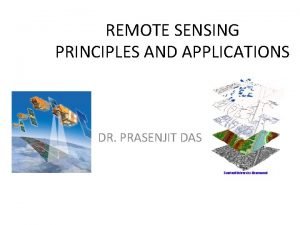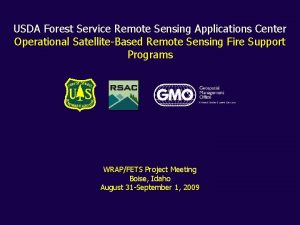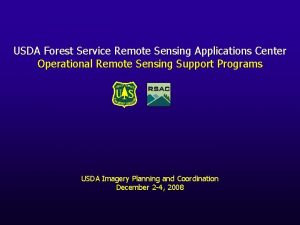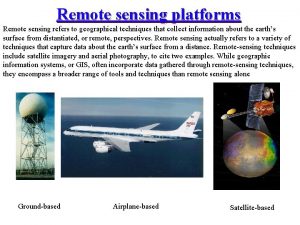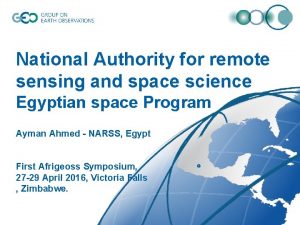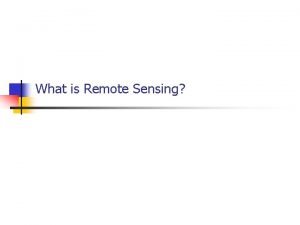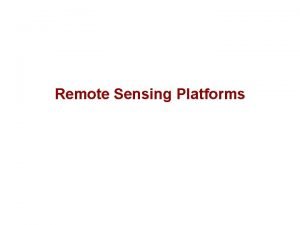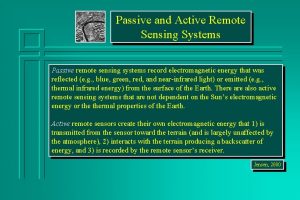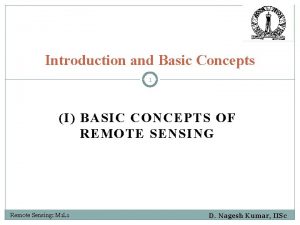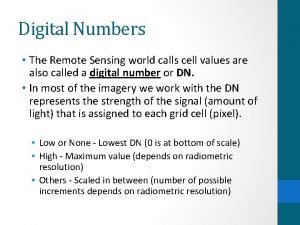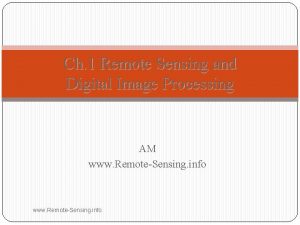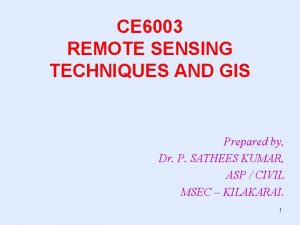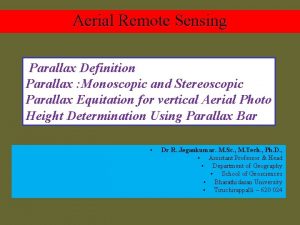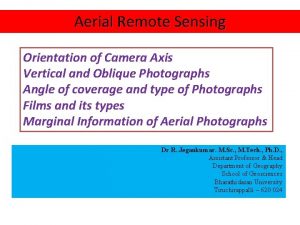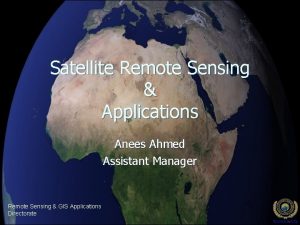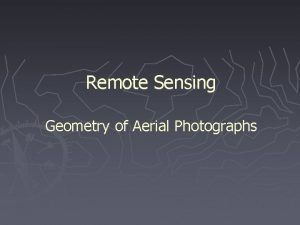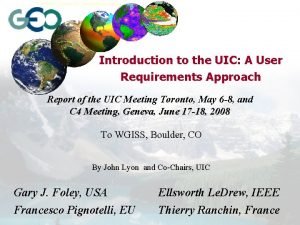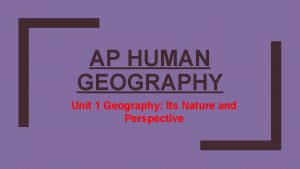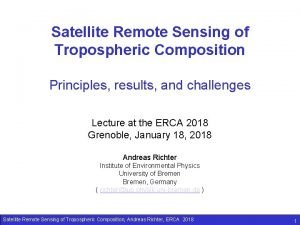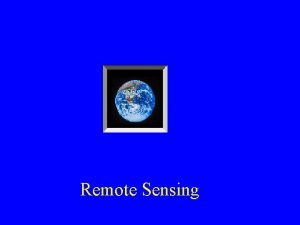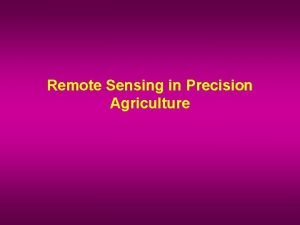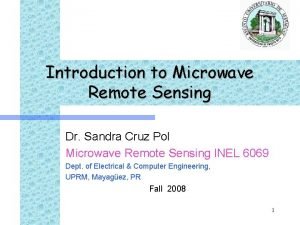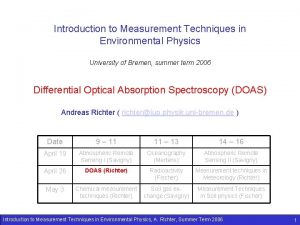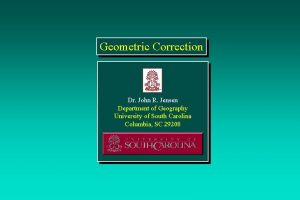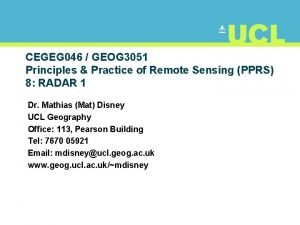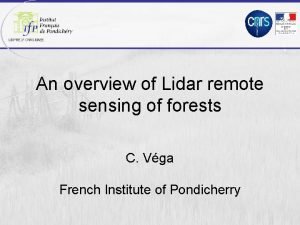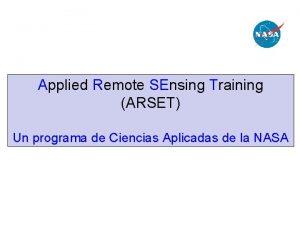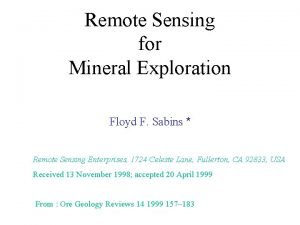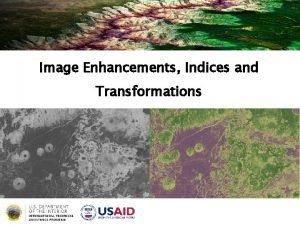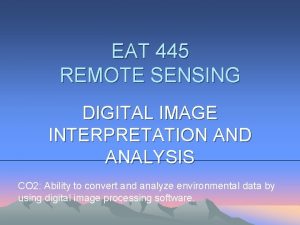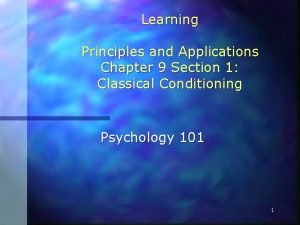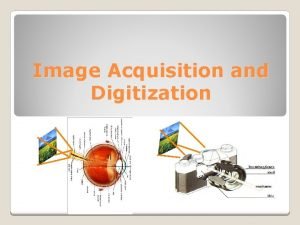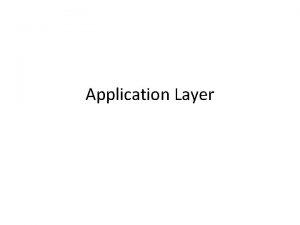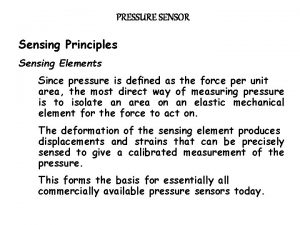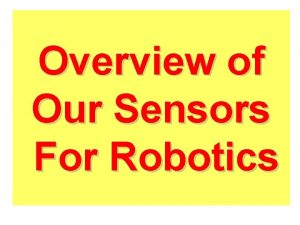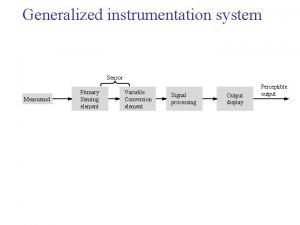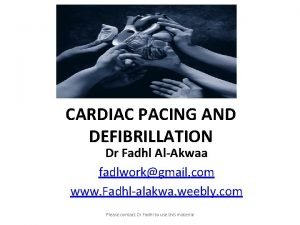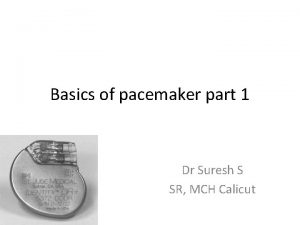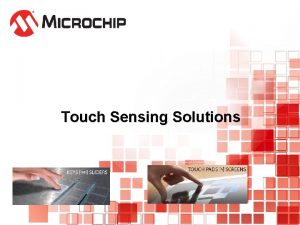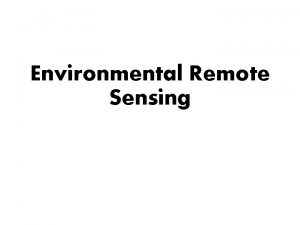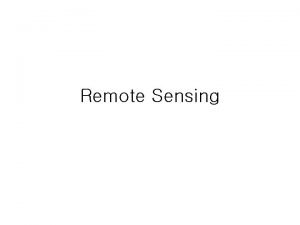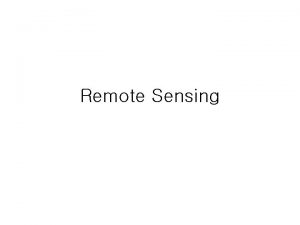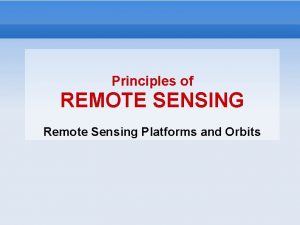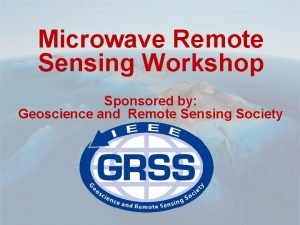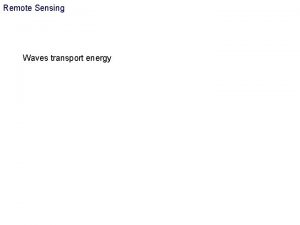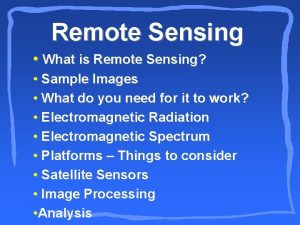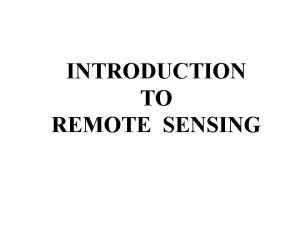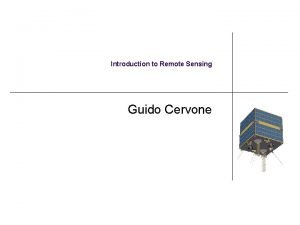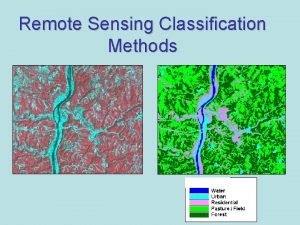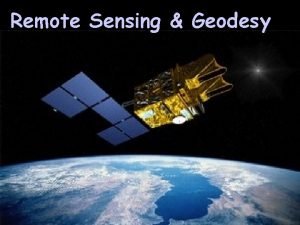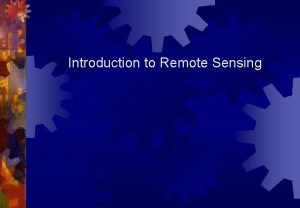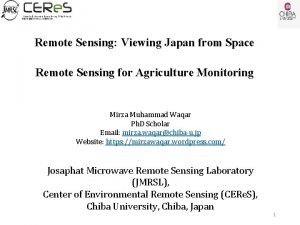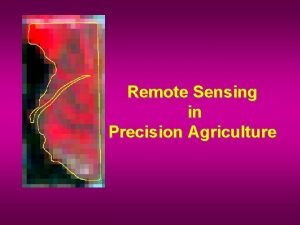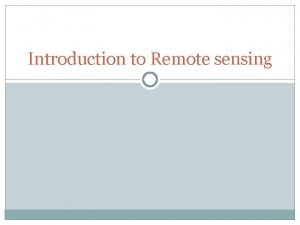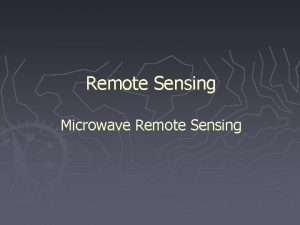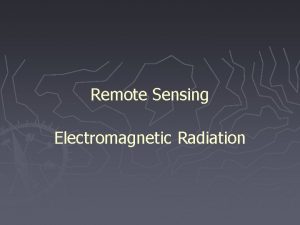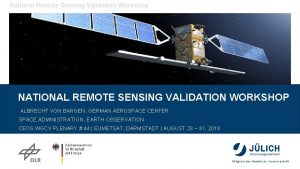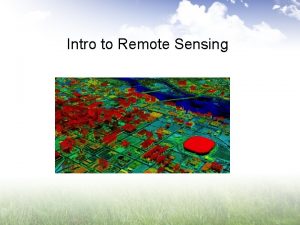REMOTE SENSING PRINCIPLES AND APPLICATIONS DR PRASENJIT DAS
























































- Slides: 56

REMOTE SENSING PRINCIPLES AND APPLICATIONS DR. PRASENJIT DAS

Remote Sensing Definition Science and art of obtaining information about an object, area or phenomenon through an analysis of data acquired by a device that is not in direct contact with the area, object or phenomenon under investigation. Lillesand, Thomas M. and Ralph W. Kiefer, “Remote Sensing and Image Interpretation” John Wiley and Sons, Inc, 1979, p. 1 What are some common examples of remote sensors?

Remote Sensing “the art, science, and technology of obtaining reliable information about physical objects and the environment, through the process of recording, measuring and interpreting imagery and digital representations of energy patterns derived from noncontact sensor systems”

History of Remote Sensing 1609 - Invention of the telescope Galileo

History of Remote Sensing 1859 - First aerial photographer Gaspard Felix Tournachon, also known as Nadar 1862 - US Army balloon corp

History of Remote Sensing 1908 - First photos from an airplane 1914 -1918 - World War I First flight, Wright Bros. , Dec. 1903

COMPONENTS OF REMOTE SENSING Electromagnetic Radiation(EMR) Sensors Sensor carrying platforms

Electromagnetic Radiation(EMR) INTRODUCTION Radiation is one of the three commonly recognised modes of transference of energy, the others being conduction, and convection. Radiation is unique among the three in that radiated energy can be transferred across free space as well as through a medium such as air. Thus sunlight a form of radiant energy crosses the gulf of emptiness between the sun and the earth. The radiant energy is called Electromagnetic energy in recognition of the fact that it has both electric and magnetic components.

Electromagnetic waves are energy transported through space in the form of periodic disturbances of electric and magnetic fields. All electromagnetic waves travel through space at the same speed, c = 2. 99792458 x 108 m/s, commonly known as the speed of light. An electromagnetic wave is characterized by a frequency and a wavelength. These two quantities are related to the speed of light by the equation, speed of light = frequency x wavelength

This chart illustrates how visible colors of light can represent frequencies of electromagnetic radiation that the human eye can not “see”. http: //chandra. harvard. edu/photo/false_color. html

The frequency (and hence, the wavelength) of an electromagnetic wave depends on its source. There is a wide range of frequency encountered in our physical world, ranging from the low frequency of the electric waves generated by the power transmission lines to the very high frequency of the gamma rays originating from the atomic nuclei. This wide frequency range of electromagnetic waves constitute the Electromagnetic Spectrum.

The Electromagnetic Spectrum The electromagnetic spectrum can be divided into several wavelength (frequency) regions, among which only a narrow band from about 400 to 700 nm is visible to the human eyes.

SENSORS USED IN REMOTE SENSING Sensors may be classified as active or passive, image or non-image forming, commercial or military. An active sensor provides its own source of illumination, whereas the passive sensor does not. Photographic camera is a passive sensor when used in sunlight, while a camera with flash bulb is active sensor. A radar and a laser altimeter are active sensors. Passive sensors can only be used to detect energy when the naturally occurring energy is available. For all reflected energy, this can only take place during the time when the sun is illuminating the Earth. There is no reflected energy available from the sun at night. Energy that is naturally emitted (such as thermal infrared) can be detected day or night, as long as the amount of energy is large enough to be recorded.

ACTIVE SENSOR Active sensors, on the other hand, transmit short bursts or 'pulses' of electromagnetic energy in the direction of interest and record the origin and strength of the backscatter received from objects within the system's field of view. Passive systems sense low level microwave radiation given off by all objects in the natural environment. Advantages for active sensors include the ability to obtain measurements anytime, regardless of the time of day or season. Active sensors can be used for examining wavelengths that are not sufficiently provided by the sun, such as microwaves, or to better control the way a target is illuminated. However, active systems require the generation of a fairly large amount of energy to adequately illuminate targets. Some examples of active sensors are a laser fluorosensor and a synthetic aperture radar (SAR)

Radar imaging systems such as ERS (European Remote Sensing Satellite), JERS (Japan Earth Resources Satellite), and RADARSAT-1 are active systems. They both transmit and receive energy. Microwave scanning radiometers only receive microwave energy. One advantage of active radar sensing systems is that, since they provide their own source of energy, they can collect data at any time of the day or night. Passive sensors - optical, thermal, and microwave rely on receiving the naturally emitted or the sun's reflected energy from the Earth's surface and can therefore image only during the daytime .

Sensor carrying platforms The base, stationary or moving, on which remote sensors are mounted is called a remote sensing platform. The remote sensing platforms range fro a camera on a tripod or a balloons, helicopters, aircrafts, rockets and spacecrafts. The choice of a particular platforms is mainly guided by the choice of sensors which is guided by the objectives of the programme. However other key factors in the choice of a platform are the payload, operating height, operating range, time and cost.

Remote Sensing Platforms - Ground based - Aircraft - Space shuttle - Satellite

Balloons are rather inexpensive platforms and offer a great variety of shapes, sizes and performance characteristics. Free floating or anchored balloons have been used to a limited extent for the aerial photography of water bodies such as bays and lakes to trace water circulation, sedimentation, etc. They provide large field of view and in general, require no power. They have low acceleration and hence delicate instruments can be mounted. They also exhibit low vibrations. The greatest disadvantage of free balloons is that their flight trajectory may not be controllable and they too much depend on meteorological conditions, particularly the winds. There are three main types of balloon system 1. Free balloons 2. Tethered balloons 3. Powered balloons.

AIRCRAFT Aircraft have been used extensively as remote sensing platforms for land coastal mapping, oceanographic studies and the spotting of fish schools. This is one of the most efficient methods of remote sensing the earth's surface at larger scales. Aircraft have the advantage of optimizing data acquisition by providing operator access to the remote sensing instrumentation and by allowing a wide choice of acquisition parameters. A remote sensing mission can be performed over a particular area at a specified time (weather permitting) and may be repeated under controlled conditions.

The Aerial Photograph • Aerial photographs are a very useful source of data for environmental surveys. They have applications in: • Topographic surveying • Geomorphology • Geology and resource surveys • Soil surveys • Land use and crop management • Urban and/or industrial development • Archaeology • eomorphology • Geology and resource surveys

The Aerial Photograph • There are three types of film in common use: -- white panchromatic – True colour – False colour infra-red • Each of these has their particular advantages and drawbacks. • They are complementary - not alternatives.

The Aerial Photograph

The Aerial Photograph Scale and Distortion • The scale of a vertical photo is the ratio of the flying height to the focal length of the lens. If the ground height varies, the scale will thus change. • This is seen as a displacement of the image point along a line radially outwards from the centre of the photograph. • The amount of displacement depends on the height of the image point and increases towards the edge of the photograph. • Thus an aerial photograph is NOT a map.

The Aerial Photographic Tone • Tone is the brightness of a black and white image. It is determined by the intensity of light falling on the photographic emulsion for a given duration. • Over a given range the tone is linearly related to the light intensity - the gradient of this relationship is the sensitivity of the film. • The range of tones in the image is its contrast.



The Aerial Photographic Colour • True colour photographs record the intensity in several wavelengths using the tone range of dyes, usually red, green and blue.

A suitable altitude can be chosen to optimize resolution and coverage area. Commercially available aircraft can reach an altitude of 15 km. Aircraft can be equipped with black and white, colour or colour infrared (CIR) photographic equipment, multispectral scanners or active sensors such as radar. The main disadvantages of remote sensing from aircraft are the instability of the platform, the limited geographic coverage (due to the relatively low altitude of the aircraft), the high cost and the dependence on weather conditions. This method, therefore, is used mainly for time- critical missions. When the mission requires repetitive imaging of the same area, the significantly lower access cost of satellite data generally is preferred.



The Aerial Photographic Colour • False colour photographs use one colour to record the tone range in another wavelength, e. g a red colour is used to show infra-red radiation.


Thematic Interpretation • The evidence from a single photo is usually quite limited. At the very least a stereo pair will give surface relief and texture. • Ideally different types of photo should be used together - e. g. black & white plus colour or infra-red. This a simple example of so-called multispectral sensing

Outline of aerial surveys • Vertical aerial photos are taken along the flight line at intervals which allow for a 60% overlap of each photo. Successive flight lines side-lap by ca. 30%. • Survey cameras are of 150 -200 mm focal length and use largeformat film from which standard sized prints (250 mm square) are made. • The cameras are mounted on gimbols which ensure the optical axis remains (nearly) vertical in flight.

Outline of aerial surveys • The overlap allows pairs of photographs to be viewed stereoscopically - each part of the ground is photographed from two positions. • The use of a 60% overlap allows every alternate photo to be removed to leave a photomosaic which still has 10% overlap for matching.

Satellite With the use of satellites as remote sensing platforms it has been possible to overcome some of the difficulties encountered in remote sensing with aircraft. Satellites can monitor the entire earth surface on a periodic basis, covering a sizeable section on each revolution. Satellites designed for remote sensing on an operational basis are generally unmanned. Nevertheless, some manned satellites have provided valuable information despite the short duration of their mission, e. g. , SKYLAB, SOYUZ and space shuttles.

ORBITS Geostationary orbit (appr. 36. 000 km) Near Polar orbit (appr. 500 -1000 km)

MAJOR EARTH OBSERVING SATELLITES Landsat SPOT Ikonos AVHRR Seawifs GOES Meteosat Terra EOS Satellite (ASTER, MODIS, CERES, MOPITT, MISR

LANDSAT

LANDSAT • Swath Width: 185 km • Repeat Cycle 16 days • Orbit Altitude: 705 km • Equatorial Crossing: at around 10 a. m. local solar time

1. Satellite orbits “Sun-synchronous” Land monitoring ~ 700 km altitude “Geostationary” Weather satellites ~ 30, 000 km altitude

Satellite orbits Geostationary / geosynchronous : 36, 000 km above the equator, stays vertically above the same spot, rotates with earth - weather images, e. g. GOES (Geostat. Operational Env. Satellite)

Sun-synchronous Ascending and Descending passes Geostationary satellites capture a (rectangular) scene, sun-synchronous satellites capture a continuous swath, … which is broken into rectangular scenes.

3. Sensor groups Multi-spectral sensors record bands in multiple wavelengths: Visible Near IR Mid IR Thermal Microwave And at different spatial resolutions: Low Medium High Very high Many satellites carry multiple sensors with different resolutions Some sensors have more than one resolution

Free floating or anchored balloons have been used to a limited extent for the aerial photography of water bodies such as bays and lakes to trace water circulation, sedimentation, etc. Balloons are of limited use for the remote sensing of vast ocean surfaces due to their instability and slow speed.


Satellite Observations Types of Orbits (Con’t) • Highly Elliptical Orbits (HEO) - Typically pass low (1, 000 km) over the southern regions, then loop high over the northern regions - One pass every 4 to 12 h - Used in communications to provide coverage of the higher latitudes and the polar regions

Satellite Observations Types of Orbits (Con’t) • Geosynchronous - Orbital period of 1 day, i. e. , satellite stays over the same spot on the Earth - Orbital radius is 42, 164 km or 35, 786 km above the Earth’s surface at the Equator where the Earth’s radius is 6. 378 * 106 m - Used for many communication satellites; > Cover a country like Australia > Don’t require complex tracking dishes to receive the signals; Note: satellite stay stationary relative to Earth

Satellite Observations Types of Orbits (Con’t) • Geosynchronous (Con’t) - Weather satellites > GOES (Geosynchronous Operational Environmental Satellites) Satellite

The Importance of RS • Large amounts of data needed, and Remote Sensing can provide it • Reduces manual field work dramatically • Allows retrieval of data for regions difficult or impossible to reach: – – • Open ocean Hazardous terrain (high mountains, extreme weather areas, etc. ) Ocean depths Atmosphere Allows for the collection of much more data in a shorter amount of time – Leads to increased land coverage AND – Increase ground resolution of a GIS • Digital Imagery greatly enhances a GIS – DIRECTLY: Imagery can serve as a visual aid – INDIRECTLY: Can serves as a source to derive information such as… • • • Land use/land cover Atmospheric emissions Vegetation Water bodies Cloud cover Change detection (including sea ice, coastlines, sea levels, etc. )

Applications of Remote Sensing • Images serve as base maps • Observe or measure properties or conditions of the land, oceans, and atmosphere • Map spatial distribution of “features” • Record spatial changes

Change Detection - Flooding Landsat imagery of the 1993 Mississippi flood

Monitoring Weather GOES-8 Water Vapor

Monitoring Sea Surface Temperature

Change Detection - Urban Sprawl

 Dr prasenjit das
Dr prasenjit das Remote sensing applications center
Remote sensing applications center Remote sensing applications center
Remote sensing applications center Ifov and fov in remote sensing
Ifov and fov in remote sensing National authority for remote sensing and space sciences
National authority for remote sensing and space sciences Energy transfer
Energy transfer Remote sensing platforms
Remote sensing platforms Active vs passive remote sensing
Active vs passive remote sensing Components of remote sensing
Components of remote sensing Digital number in remote sensing
Digital number in remote sensing Limitations of remote sensing
Limitations of remote sensing Idealized remote sensing system
Idealized remote sensing system Aggregation definition ap human geography
Aggregation definition ap human geography Remote sensing ap human geo
Remote sensing ap human geo Parallax in remote sensing
Parallax in remote sensing Strip camera in remote sensing
Strip camera in remote sensing Remote sensing image
Remote sensing image Fiducial axis in aerial photography
Fiducial axis in aerial photography Canada centre for remote sensing
Canada centre for remote sensing Disbursed ap human geography
Disbursed ap human geography Remote sensing physics
Remote sensing physics Microwave remote sensing lecture notes
Microwave remote sensing lecture notes Remote sensing in precision agriculture
Remote sensing in precision agriculture Aerial photography in remote sensing pdf
Aerial photography in remote sensing pdf Introduction to microwave remote sensing
Introduction to microwave remote sensing Remote sensing physics
Remote sensing physics Geometric errors in remote sensing
Geometric errors in remote sensing Cegeg
Cegeg Full waveform lidar
Full waveform lidar Supervised classification
Supervised classification Applied remote sensing training program
Applied remote sensing training program Advantages of remote sensing
Advantages of remote sensing Remote sensing
Remote sensing Digital interpretation in remote sensing
Digital interpretation in remote sensing Remote user authentication principles
Remote user authentication principles Terahertz spectroscopy principles and applications
Terahertz spectroscopy principles and applications Sport management principles and applications
Sport management principles and applications Principles and applications of electrical engineering
Principles and applications of electrical engineering Allan
Allan Learning principles and applications
Learning principles and applications Das alte ist vergangen das neue angefangen
Das alte ist vergangen das neue angefangen Eu fico a pureza da resposta
Eu fico a pureza da resposta Das alles ist deutschland das alles sind wir
Das alles ist deutschland das alles sind wir Jesus ich bin das licht der welt
Jesus ich bin das licht der welt O menosprezo das artes e das letras
O menosprezo das artes e das letras Sensing intuition feeling thinking
Sensing intuition feeling thinking Demand sensing and shaping
Demand sensing and shaping Customer linking capabilities
Customer linking capabilities Image acquisition and digitization
Image acquisition and digitization Principles of network applications
Principles of network applications Principles of network applications
Principles of network applications Pressure sensing elements
Pressure sensing elements What is sensing
What is sensing Generalized instrumentation system
Generalized instrumentation system Pacemaker not sensing
Pacemaker not sensing Pacemaker not sensing
Pacemaker not sensing Touch sensing solutions
Touch sensing solutions
